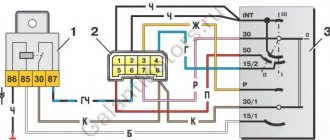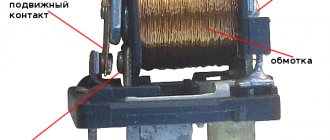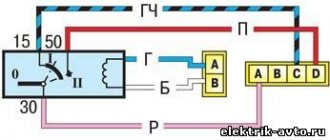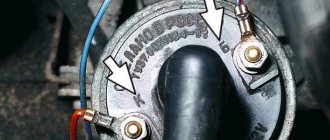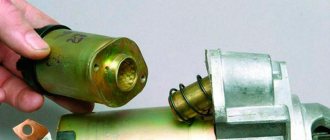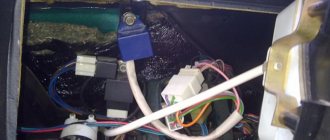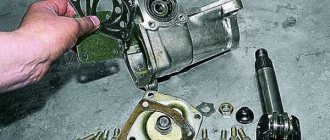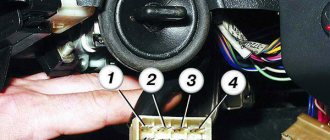The ignition switch in cars of the VAZ family fails from time to time due to weakening of the contact posts or burning of the contacts inside it.
It also happens that the cams of a plastic roller are produced. You can disassemble the lock and clean it, but it’s better to just replace it with a new one, considering that it costs pennies compared to imported locks. But if connecting the wires together did not result in the starter operating (or it did not turn on the first time), check the solenoid relay on the starter. The contact spots on it may also burn out, which will prevent the circuit from closing normally. Alternatively, you can use a screwdriver to short-circuit the two large terminals on the solenoid relay (before doing this, put the car in neutral and use the handbrake). When closed, the starter should begin to spin vigorously. If this happens, remove and change the solenoid relay. If the starter rotates “sluggishly” when it closes, you will have to remove it and check the condition of the brushes.
All operations are performed with your own hands, without the help of car service specialists. Moreover, the price of an ignition switch on a VAZ2106 is up to 100 rubles. To replace it, you will need to know the pinout of the wires coming from it, for which the editors of the site 2 Schemes.ru have prepared a large reference material.
The ignition switch is designed not only to start the engine - it performs several functions at once:
- supplies voltage to the vehicle’s on-board network, closing the circuits of the ignition system, lighting, sound alarm, additional devices and instruments;
- at the driver’s command, turns on the starter to start the power plant and turns it off;
- turns off the power to the on-board circuit, preserving the battery charge;
- protects the car from theft by fixing the steering shaft.
Pinout of the ignition switch VAZ-2101 - VAZ-2107
The ignition switch on these cars is located to the left of the steering column. It is fixed directly to it using two fixing bolts. The entire mechanism of the device, except for the upper part in which the keyhole is located, is hidden by a plastic casing.
On the visible part of the ignition switch housing, special marks are applied in a certain order, allowing inexperienced drivers to navigate the lock activation mode when the key is in the hole:
- “” – a mark indicating that all systems, devices and instruments that can be turned on using the lock are turned off (this does not include the cigarette lighter, interior lighting, brake light, and in some cases the radio);
- “ I ” is a mark informing that the vehicle’s on-board network is powered from the battery. In this position, the key is fixed independently, and electricity is supplied to the ignition system, to the electric motors of the heater and windshield washer, instrumentation, headlights and light signaling;
- “ II ” – engine start mark. It indicates that voltage is applied to the starter. The key does not lock in this position. If you release it, it will return to the "I" position. This is done so as not to subject the starter to unnecessary loads;
- “ III ” – parking mark. If you remove the key from the ignition in this position, the steering column will be locked with a latch. It can only be unlocked by inserting the key back and turning it to position “0” or “I”.
The ignition switch has five contacts and, accordingly, five terminals, which are responsible for supplying voltage to the desired unit. All of them are numbered for convenience. Each pin corresponds to a wire of a certain color:
- “50” – output responsible for supplying current to the starter (red or purple wire);
- “15” – terminal through which voltage is supplied to the ignition system, to the electric motors of the heater, washer, and instrument panel (double blue wire with a black stripe);
- “30” and “30/1” – constant “plus” (pink and brown wires, respectively);
- “INT” – external lighting and light signaling (double black wire).
Troubleshooting methods
Before replacing, repairing and installing a new protection device, we suggest learning in more detail about several ways to solve the problem:
- Removing and replacing the device with a new one. Many car owners change their car parts because they don’t want to do their own repairs and waste their time and effort on it. Sometimes this approach is actually worthwhile if the problem is serious.
- Disassemble the device and identify failed elements, and then replace them. As a rule, the cause of the malfunction lies in problems in the operation of the contact group. Before connecting a new group, you need to take into account the color pinout of the contacts; it is important to follow it.
If you change the lock, then keep in mind that you will also need to change the cylinder in the door lock, as well as in the luggage compartment lock . Otherwise, the key will not be able to open the trunk and doors (author of the video channel Region 4253).
Pinout of lock VAZ-2108, VAZ-2109, VAZ-21099
Pinout according to the old type
Pinout of the VAZ-2109 ignition switch with unloading relay:
- comes +12V in position I, II, III (parking)
- comes +12V in position I, II, III (parking)
- comes +12V in position III (parking)
- position I, +12V goes out after turning on the ignition (contact 15/2), disappears at start (II);
- position I, +12V goes to the starter (pin 50);
- position I, +12V goes away after turning on the ignition (pin 15), does not disappear when starting II;
- +12V comes from the battery (pin 30);
- comes +12V constantly.
New pinout type
Pinout of the new VAZ-2109 ignition switch:
- comes +12V constantly
- comes +12V constantly
- +12V arrives after turning on the ignition (pin 15), does not disappear when starting II;
- +12V arrives after turning on the ignition (contact 15/2), disappears at start (II);
- position I, +12V goes to the starter (pin 50);
- +12V arrives after turning on the ignition (pin 15), does not disappear when starting II;
- +12V comes from the battery (pin 30);
- comes +12V constantly.
Features of electrical wiring of “classic” models
The main characteristics of the VAZ 2106 wiring diagram are the following:
- activation of electrical circuits directly through the ignition switch;
- connection to the battery using the fuse box;
- conductive housings of key components.
Color factory diagram (1900x1500) of electrical components.
Thus, in the event of a failure of any system, it is advisable to look for faults directly from the ignition switch and contact group.
The role of this node is as follows:
- controls the vehicle ignition system;
- plays anti-theft, including security functions;
- allows you to tow a faulty car with the hazard lights on.
Pinout of lock VAZ-2110, VAZ-2111, VAZ-2112
Pinout of the ignition switch VAZ-2110:
- comes +12V for the microphone of the sensor of the inserted key;
- the mass comes when the driver's door is open;
- +12V goes to the starter (pin 50);
- +12V goes out after turning on the ignition (pin 15);
- +12V goes out when the key is inserted to pin 5 of the BSK;
- comes +12V to illuminate the lock cylinder;
- +12V comes from the battery (pin 30);
- not used.
Useful: VAZ dashboard pinout
Mechanical part
Often, mechanical failure of the ignition switch is provoked by:
- tight turning of the ignition key;
- jamming in one of the positions. As a rule, such a problem leads to a broken ignition key, which, in turn, requires additional expenses for purchasing a new part.
Basically, these problems arise due to poor assembly of the ignition switch from unscrupulous manufacturers. So that the product does not have to be changed frequently, you need to install a reliable and durable part.
Pinout of lock VAZ-2113, VAZ-2114, VAZ-2115
Pinout of the ignition switch VAZ-2113, 2114, 2115:
- comes +12V for the microphone of the sensor of the inserted key;
- the mass comes when the driver's door is open;
- +12V goes to the starter (pin 50);
- +12V goes out after turning on the ignition (pin 15);
- +12V goes out when the key is inserted to pin 5 of the BSK;
- comes +12V to illuminate the lock cylinder;
- +12V comes from the battery (pin 30);
- not used.
Engine start button
Many owners of “classics” install a button to make starting the engine more convenient. The button is connected to the starter power circuit, into the gap in the red wire which is connected to pin 50 on the lock. The engine is started according to the following algorithm:
- The key in the lock is set to position one.
- Turn on the starter by pressing the button.
- As soon as the engine starts, the button is released and movement begins.
- In order to stop the engine, you need to turn the key to position zero.
The structure of a car ignition switch
- Locking rod
- Frame
- Roller
- Contact disc
- Contact sleeve
- Block
- Protrusion of the contact part.
The lock mechanism is connected to many wires. They continue from the battery, connecting all the electrical devices of the car into a single chain. When you turn the ignition key, the electrical circuit is closed from the “-” terminal of the battery to the ignition coil. As a result, the current passes through the wires to the ignition switch, through its contacts it is directed to the induction coil, after which it returns back to the “+” terminal. As electricity passes through the coil, it generates high voltage, which it transmits to the spark plug. Therefore, the key closes the contacts of the ignition circuit, thereby starting the car engine.
Replacing the contact group
Sometimes there is no need to completely change the lock mechanism. It is enough just to change the contact group.
It is located on the back of the mechanism. Attached to the body with a spring ring. You can try to remove it by hand or using a screwdriver.
We film the group itself. It consists of two plastic rings that have built-in current-carrying tracks. There is a spring inside the ring.
Over time, carbon deposits form on these tracks, which leads to failure. There is no point in messing around with this soot. It's easier to buy a new group in the store. Its cost for a VAZ 2106 does not exceed 50 rubles.
Please note that there are different models. On some, the starter contact is attached so that when you turn the key, the contact bends. This leads to quick breakdowns. It is better to choose a model on which the contact is rigidly installed.
Installing a new part is easy. Alternately move the wires from the previous part, choosing the correct contacts. Place the key in the zero position, turn the top of the group to the left until it stops and insert it into the lock. Make sure that the blade inside the body fits into a special groove. Snap and slide on the snap ring.
Preparatory stage
Many people are interested in the question of how to install contactless ignition on a VAZ 2106 if there is no garage and inspection hole. But this device does not require an inspection hole; all operations can be performed near the hood. Additional auxiliary equipment required:
- Set of keys (for 8,10,13);
- Two screwdrivers - flat and Phillips;
- Pliers;
- Drill (use of drills for working with metal is allowed);
- Screws.
You can also borrow a spanner wrench that has a long handle. It will allow the crankshaft to rotate. If it is not found, then you can use the method of rotating the rear wheel, after placing the anti-recoil objects and turning on 4th or 5th speed.
When solving the problem of how to install electronic ignition on a VAZ 2106, first you need to carry out the preparation stage:
- Open the car hood;
- Remove the negative terminal of the battery;
- Remove the wires from the spark plugs and the distribution device;
- Unscrew the spark plugs.
Next, you need to prepare a new kit and begin the dismantling process.
